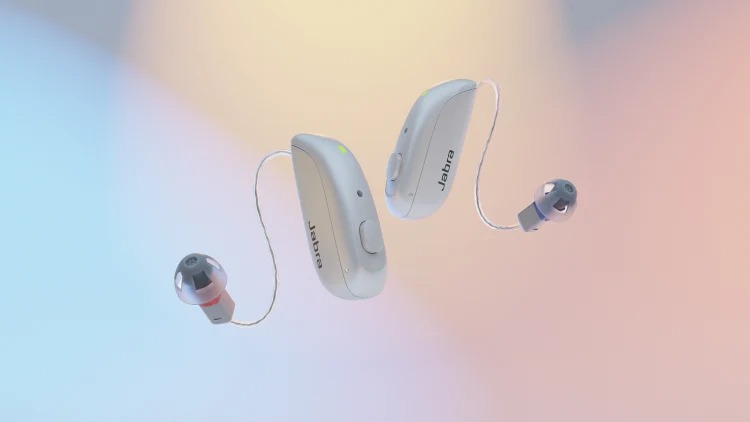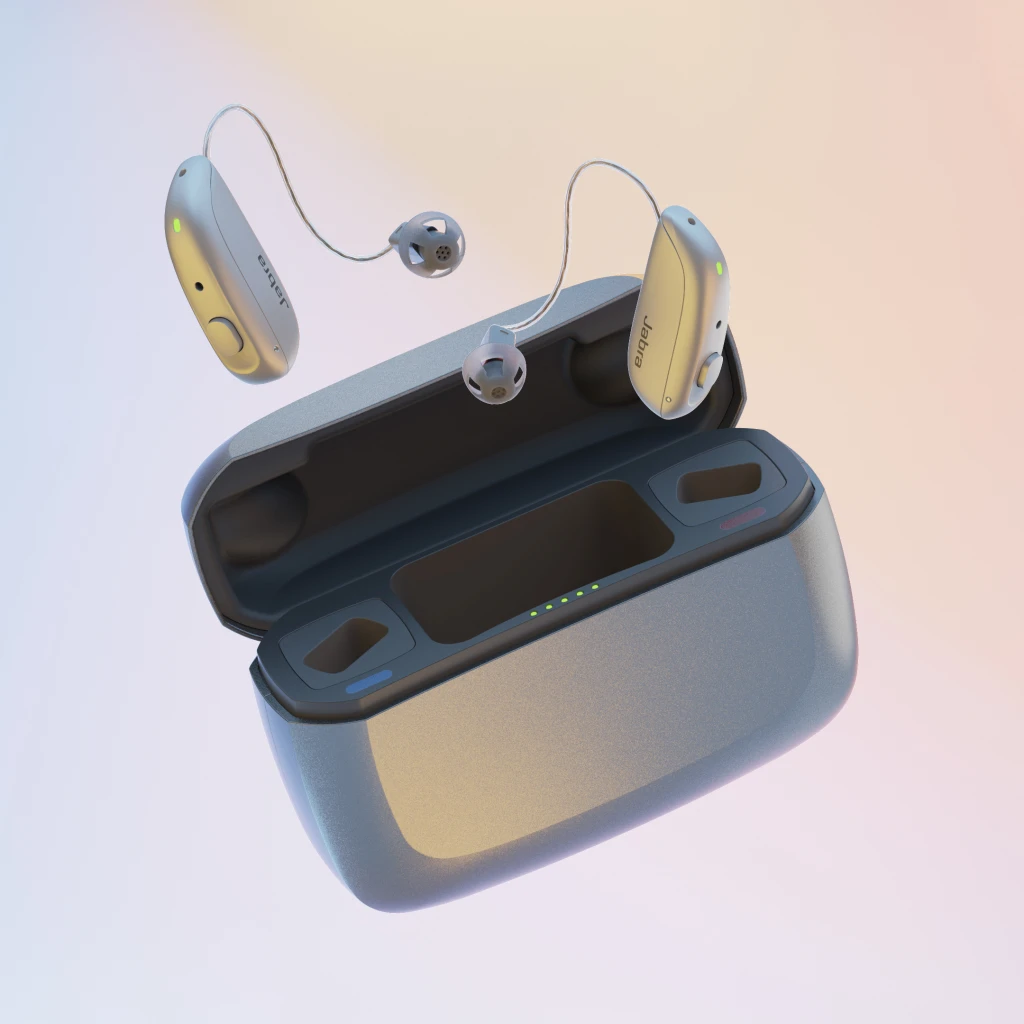- | 8:00 am
Jabra’s obsession with design led to its new line of hearing aids
The audio company is looking to bridge the gap between O.T.C and prescription hearing aids.

There’s a tweet from a few years ago that’s always stuck with me that reads: “According to most health insurance companies, teeth are luxury bones that I must pay more to continue enjoying. It perfectly sums up the absurdity of the U.S. healthcare system in how it really isn’t designed to address the well-being of the whole person, but rather categorizes individual body parts as either essential or non-essential when determining what medical services you can receive. Like dental and vision, hearing care requires additional coverage from both private insurance and Medicare, and while some insurance plans offer partial coverage for assistive devices like hearing aids, many people still face substantial out-of-pocket expenses.
For the 60 million people in the U.S. who live with some degree of hearing loss, audiologist Briana Owen says funding is the primary access barrier to obtaining hearing aids. “Costs vary significantly between nonprofit hospitals and private practitioners, with different billing methods like bundled services or fee-for-service influencing the final price tag,” she explains. “But it also depends on where you are geographically. You could easily drop $10,000 on a set of hearing aids if you’re in New York City, whereas a smaller town in a different state might only cost $3,000.”
The introduction of over-the-counter (O.T.C.) hearing aids has aimed to alleviate this financial burden, providing more affordable options without the need for a prescription. However, while O.T.C. hearing aids offer the benefits of lower costs and increased accessibility, they come with potential drawbacks, including limited customization and lower sound quality compared to professionally fitted devices. That’s where consumer audio company Jabra has stepped in to disrupt the current O.T.C. marketplace with a line of high-quality over-the-counter (O.T.C.) hearing aids that rival those you would receive from a doctor’s office.
According to Steve Jacobs, president and chief product officer at Jabra Hearing, the company’s mission is to bridge the gap between O.T.C. and prescription hearing aids by utilizing a direct-to-consumer model that includes the support of state-licensed and routed telehealth audiologists. “Consumers have this expectation that over-the-counter hearing aids are less powerful or less customizable to their unique needs. But what we’re offering is really the best of both worlds; you’re getting a powerful hearing aid at an affordable and accessible price, while still getting the benefit of an audiology team at your disposal via remote care,” Jacobs says.
The Jabra Enhance line of O.T.C. hearing aids comes in three different models ranging from $995 to $1,995, along with a 100 day free trial. Jabra offers a Premium Package care plan baked into the price of its latest model, the Select 500, that includes access to support from their audiology team for three years. The Select 500 is Jabra’s smallest and most advanced hearing aid to date. It features a “Micro RIE” design, 25% smaller than standard receiver-in-ear aids and is 15% smaller than its predecessor, the Select 300. It utilizes SoundScape™ technology to enhance speech clarity and reduce background noise for natural, immersive listening in any environment, and includes Bluetooth features like Bluetooth LE Audio for improved audio quality and battery life, as well as Auracast™ for live broadcast audio in public venues.

‘We’re obsessed with design’
Even though I often cover assistive technology, I don’t live with hearing loss, so I enlisted the help of my mother Kathy to wear the Select 500s, and let me observe her experience while using the devices as well as the onboarding process with Jabra’s audiologist. She has moderate hearing loss and has considered getting a set of prescription hearing aids but was deterred by the out-of-pocket cost. She’s explored other consumer tech options for hearing enhancement like the accessibility features on the Apple Airpods Pro, but didn’t like the feeling of occlusion that the airpods created in her ears, and the battery life was not enough to last throughout the day.
Before purchasing the Select 500 hearing aids, customers take an online hearing test, beginning with general questions about the types of environments where they struggle to hear clearly, while also giving them the option to upload an audiogram if they’ve already had their hearing tested at a doctor’s office. The evaluation started with a headphone volume test that played the 1960s pop song “For What It’s Worth” by Buffalo Springfield.
Kathy noted that the familiarity of song put her at ease before moving on to the next step of testing her hearing in both ears with sustained tones at various frequencies. She also appreciated the easy-to-navigate interface of the website and how her results were displayed in an illustrated graph accompanied by a video of a doctor explaining the test based on her results, rather than just a written report. All of these elements contributed to an overall positive user experience, which is a crucial first step in helping users get comfortable with any new device.
“We’re obsessed with design,” Jacobs says, “and making our products simple and easy to use is a top priority, whether that’s a website, an app, or the hardware itself. We really try to understand the customer and what makes them tick—what are they nervous about? What are they excited about? Our job is to guide them through this process, because hearing is a complex system, as is selecting the most appropriate hearing aids for an individual’s unique needs. That’s where design comes in to make that process as streamlined as possible.”
Testing the Jabra Select 500s
A few days later after the online test, Kathy’s customized hearing aids arrived in the mail. The sleek packaging came with a variety of handouts and QR codes that took her to an onboarding video with diagrams for how to charge the hearing aids. For comparison, three hours of charging gives you 24 hours of use time versus Apple airpods, which only last for about five or six hours before you have to charge them again.
We downloaded the Enhance Select app, and while the initial Bluetooth connection was a little finicky, after a few attempts we were able to connect the hearing aids to her phone. The app offers preset listening environments to optimize sound in different settings. The all-around program is most suitable for everyday situations and adapts well to changing environments while the restaurant and outdoor programs enhance speech, reduce background noise or wind, and the music program is ideal for live music and performances.
New users also meet with an audiologist via Zoom to discuss their hearing history and get fitting guidance. The hearing aids come with a tool to measure the length of each ear to make sure that the wire fits properly. After measuring her ears, the audiologist determined that Kathy would be better suited using a shorter set of wires so a few days later she received the new set along with a video link for how to connect the wires, which were surprisingly simple to install.
Aside from ensuring that the devices fit properly, the key benefit of having one-on-one time with an audiologist was to answer some of Kathy’s questions based on her initial experiences of wearing the hearing aids. She was surprised by how aggressive some noises sounded, like the birds chirping outside, or the beep from the microwave. The audiologist explained that it takes about two weeks of consistent use for a person’s brain to acclimate their new hearing ability, and in her case, the devices were programmed to pick up more high frequency noises so those higher pitched sounds were going to sound more jarring at first.
Ultimately, the goal is to find the right balance between comfort and audibility so customers can contact their care team through the app to request an adjustment as needed. After the initial acclimation period, Kathy noticed a substantial improvement in her ability to hear in a variety of settings and noted that she felt more engaged in conversations at work and in social situations.
She appreciated the discreet size of the devices as well as the ability to answer phone calls via bluetooth. “I feel like a spy,” she told me after covertly answering my call by double-tapping one of the hearing aids. As a teacher, she also found the app’s different sound programs and the portability of the charger particularly useful when attending a recent school camping trip. Over the four-day trip, she was able to charge her hearing aids at night in the portable charger without needing an external power source, and shifted between program settings on the app from all-around to the outdoor program to enjoy the sounds of nature more clearly.
Overall the Select 500 combines advanced technology with a user-friendly design, making it a great option for people with mild to moderate hearing loss, especially if they’ve held off on seeking hearing care due to the cost or perceived stigma associated with using a medical device. By entering the O.T.C. market, consumer brands like Jabra are normalizing the use of assistive technology and making it more accessible to people who might otherwise continue to go without hearing care. “People wait, on average, seven years to treat their hearing loss,” says Steve Jacobs, “so just having these devices available in retail environments like Walmart, Best Buy or Amazon not only makes them more accessible, but its also a way of reducing stigma because you’re seeing them in the context of earbuds and other audio tech that we all use every day.”





































